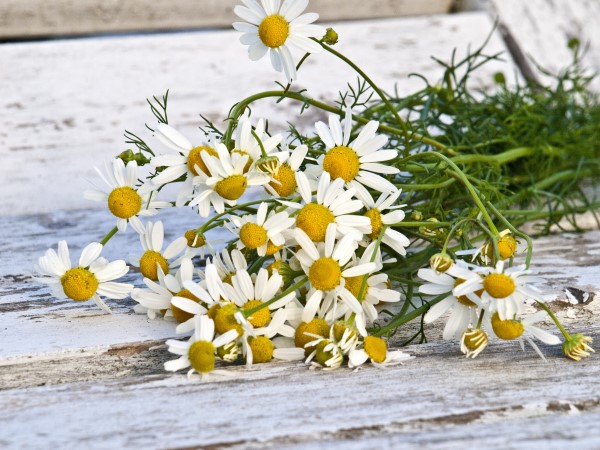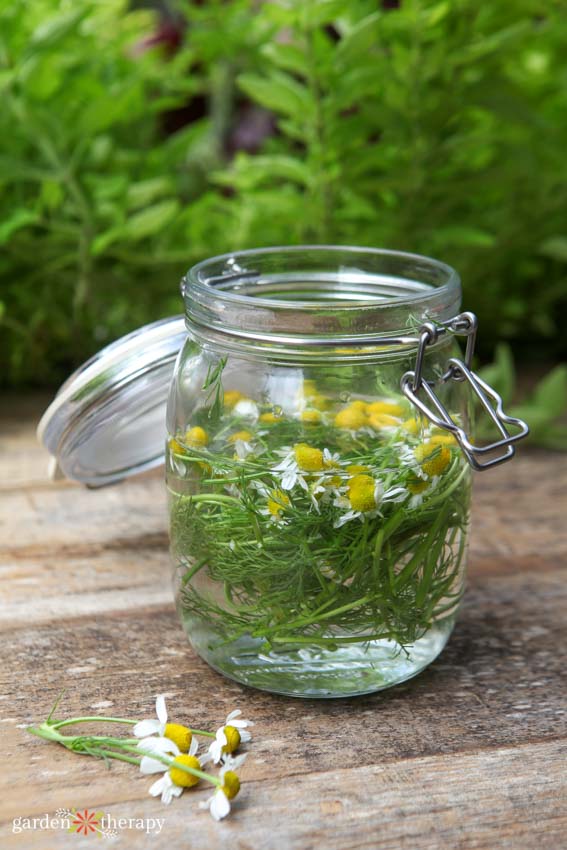Chamomile is well known as a fragrant, soothing herb that’s often enjoyed in a tea. However, chamomile flowers can offer so much more! Learn about the chamomile flower and why it’s one of my favourite herbs to grow in my own garden.

If gardens had yearbook superlatives, chamomile would probably win for “most liked” or perhaps “most helpful”. Not only does chamomile provide a host of benefits to the human body, but it’s quite helpful for your garden too. Yes, bees and other pollinators are attracted to the small daisy-like flowers, but did you know that chamomile can also repel mosquitoes and act as a natural anti-fungal agent?
This is just the tip of the iceberg for this might plant’s offerings. Let’s dig in and learn more about chamomile flowers.
Lori’s Green Blessings
This article was reviewed by herbalist Lori Snyder. This is not to be used as personal medical advice; always consult your health care professional for individual concerns.
Here is what Lori had to say:
Plants are chemical messengers who communicate with our own body chemistry. The bioflavonoid, apigenin, calms the nervous system when it is stressed or feeling anxious. How amazing that living plants who are made of the same elements as us, help so generously.
In Indigenous cultures, we recognized we are in a relationship with our living world and practiced reciprocity of taking care of each other. What a wonderful way to live and the strong essential oils make them a great partner to grow with vegetables as the aroma wards off herbivore insects.
History of Chamomile
Make no mistake, harnessing the power of chamomile is nothing new. Chamomile has been used for centuries to treat skin-related issues such as wounds, ulcers, irritations, rashes. It has also long been used as a digestive for those who overindulged or who had stomach issues.
Chamomile has also been recognized for centuries as a useful aid for soothing and sleep. In fact, in the 1902 children’s classic, The Tale of Peter Rabbit, the young rabbit is offered a soothing cup of chamomile tea upon returning home from his adventures.
Chamomile flowers and their healing properties have appeared in plenty of other books too. Ancient scientists like Galen, Dioscorides, and Hippocrates studied chamomile and shared it in their writings, recommending it as a tea.
Health Benefits of Chamomile Tea
As you can see, chamomile and its medicinal properties have certainly stood the test of time. Here are some of the most well-known benefits of this gentle, yet potent plant.
Supports the Nervous System
Chamomile does a wonderful job of soothing the nervous system. This is likely due to its abundance of apigenin, one of the bioflavonoids that act as a mild sedative. It also exerts properties that can help with anxiety.
In fact, chamomile tea is one of my favourite herbal remedies to help with sleep!
Provides Aromatherapy Benefits
Plus, a warm glass of chamomile tea offers aromatherapy benefits—the smell itself is calming to many (including me!). The sweet, floral scent is one of my go-to’s in times of stress.
Soothes Upset Stomach
If you’re in need of something to soothe a troubled stomach, look no further than chamomile. One of the biggest benefits of chamomile tea is its ability to calm a belly in turmoil.
In fact, a recent study showed that taking 500 mg of chamomile extract helped chemotherapy patients reduce their frequency of vomiting. Additionally, chamomile tea has long been used to ease colic and gas in infants.
Some people have reported that a cup of warm chamomile tea has helped tame the symptoms of heartburn. While scientific evidence for this is scant, it certainly can’t hurt to try!
Reduces Skin Irritants
Perhaps what chamomile is most well-known for is its ability to treat and soothe a long list of skin-related ailments. For those who suffer from eczema, a topical dose of chamomile has been proven to be an effective treatment.
This herb can be an effective ally against cuts, bruises, rashes, and wounds thanks to its antibacterial and anti-fungal properties.
Chamomile is gentle enough to use on babies and their ultra-sensitive skin. Strong chamomile tea can be brewed and applied to sore bottoms with diaper rash using a towel or cotton ball.

Garden Benefits of Chamomile
In addition to health benefits, chamomile flowers have quite a bit to offer your garden as well. Let’s talk about some of the most important qualities of this herb.
Anti-fungal Properties
I think the most impressive use for chamomile in the garden is to harness its anti-fungal properties to treat dampening off. I frequently treat my seeds and seedlings with a DIY anti-fungal spray made with chamomile, one of the recipes from Garden Alchemy.
Chamomile Flowers Attract Pollinators
It’s impossible to have a thriving garden without pollinators. Thankfully, an easy way to lure them to your garden is by planting chamomile! The sweet scent attracts hoverflies, wasps, bees, and ladybugs. As an added bonus, mosquitoes dislike the scent, so this is a great option to plant if you are sensitive to bites like I am.
An Excellent Companion Plant
Chamomile is one of my favourite edible flowers that pulls double duty and also works as a companion plant. Plant it next to basil, broccoli, cauliflower, or cabbage to help increase your harvest.
How to Grow Chamomile
Now that you know why you should grow chamomile, let’s dig a little deeper into how to grow this prolific herb. You’ll be amazed at how easy it is to add this cheerful plant to your garden.
Roman Chamomile vs German Chamomile

It’s important to note that there are two different kinds of chamomile: Roman chamomile (Chamaemelum nobile) and German chamomile (Matricaria recutita).
While these two plants certainly have similar properties, they are not the same. The way you grow each will differ slightly, as well the properties it produces.
Roman Chamomile
Roman chamomile is a perennial plant that tends to grow up to 1 foot high and grows along the ground.
Botanical name: chamaemelum nobile
Family: Asteraceae
USDA Zone: 4 to 9
Height: 6 to 12 inches
Spacing: 3 to 6 inches
Light: Full to partial sun exposure
Water: Average water needs. Water regularly. Do not overwater.
Warnings: Pollen may cause allergic reactions. Maybe a noxious weed or invasive
German Chamomile
German chamomile is an annual shrub. You can expect it to get up to 3 feet tall.
Botanical name: Matricaria recutita
Family: Asteraceae
USDA Zone: 3 to 9
Height: 6 to 12 inches, up to 3 feet tall
Spacing: 6 to 9 inches
Light: Full sun and full to partial sun
Water: Average water needs. Water regularly. Do not over water.
Warnings: Pollen may cause allergic reactions. Maybe a noxious weed or invasive
They will bloom all through summer and most will start to flower about a month after planting. They are a prolific herb that will spread fairly fast and can take over a garden area.
How to Harvest, Dry, and Store Chamomile

Typically chamomile will be ready to harvest in the summer months. The best time of day to do it is in the morning hours. You want the dew to be evaporated but the sun not to be high yet. This will give you the best harvest possible with the most fragrant-smelling blooms. Oh, and those blooms have the heavenly aroma of sweet apples.
When harvesting, you’ll want the flower head rather than the stem. Pinch the stalk right underneath the bloom’s head and drop it into a basket or harvesting container. If you do this daily, you can continue to harvest this herb all summer long!
How to Dry Chamomile Flowers

Rinse the blooms underneath cold water in a strainer to remove any impurities. Then, gently pat the chamomile flowers dry.
To use the flowers, you’ll need to dry the herbs out completely There are three main ways to do this:
Air Dry
This method takes the longest and also requires a good bit of space. However, it works well! Find a warm, dark place to spread the blooms out in a single layer. Then allow them to air dry for about two weeks before using them.
Use a Dehydrator

Sandwich chamomile flowers between two mesh trays in a dehydrator so you don’t lose any of the flowers. Set it at the lowest setting possible (around 35 degrees Celsius) and let dry for about 18 hours.
In the Oven
If you don’t have a dehydrator, you can also dry chamomile flowers in the oven. Line a baking sheet with a silicone mat or parchment paper, then add a single layer for blooms. Next, simply set the oven to the lowest temperature possible and leave the oven door slightly open. You’ll need to check on the flowers every 30 minutes or so to ensure they don’t overcook.
Storing Chamomile
Dried chamomile should be stored in an airtight container in a cool, dark area. When properly stored, the shelf life of dried blooms is about one year.
How to Use Chamomile
Now that you know how to grow and harvest this prolific herb, here are some ideas to help you use it! Enjoy.





Such a wonderful post. Thank you so much!!
Not much here on how to grow it. I’ve tried direct seed in any number of gardens over the years. Nada.
Maybe try starting the seed inside and then transfer to the garden after the last frost (dependent on where you live if there is one) this was my first year growing in the Midwest (USA) and I have had great success just had my first harvest.
Can camomile be made into tinctures & would there that be a good way to use it for sleep aid, anxiety, etc?,
yes, absolutely. You could take drops before bed or as needed.